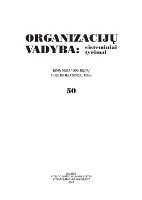Senatvės pensijų sistemos modelių teorinė analizė
MODELS OF OLD AGE PENSION SYSTEM: THEORETICAL ANALYSIS
Author(s): Tadas GudaitisSubject(s): Economy
Published by: Vytauto Didžiojo Universitetas
Keywords: senatvės pensijų sistemos modeliai; senatvės pensijų sistemos pakopos; old age pension system models; old age pension system pillars.
Summary/Abstract: Old age pension system is a key to social security. Redistribution of personal incomes and synchronization of a consumption function through the all life-cycle are the main functions of the old age pension system. Possible pension system improvements are broadly analyzed in literature on social economics research. The key parameters choosing a pension system’s model are: scope or participants, financing, administration, and rules, which describe benefits. All the parameters have some alternative values, which might be used depending on the goals of the old age pension system. The evaluation of alternative values of the parameters and possible their influence on the long term social policy goals is very important when reforming old age pension systems. Having analyzed the pension system’s financing sources and benefit models it is possible to note that there are several ways, how to balance social budget and to ensure higher replacement rate for pensioners. Pay-as-you-go or fully funded models together with defined contribution or defined benefit models might be measured differently. There are different opinions concerning the most suitable model. Recently a pay-as-you-go model has got criticism on stipulating the decrease of effectiveness in economics. Moreover, if redistribution is high and the financial difference between the old age pension and current incomes is very marked, it might force people to retire early or to work illegally. Although, fully funded models have weaknesses too. The recent crisis in financial markets has showed that accumulated capital in fully funded schemes might be less than expected. The modern 3 Pillars Pension model is based on measurements of these models. First pillar is based on pay-as-you-go defined contributions or defined benefits. Second and third pillars are based on fully funded defined contributions. After the World Bank had introduced pillar models in its policy research report “Averting old age crisis”, they were adopted in different countries. Demographical, economical, political and institutional risks might influence the pension system models. However, the impact of these risks on different financing or benefits means is different. That is why the old age pension systems based on the model of pillars might overcome the risks more effectively than one pillar pension systems. During the last decade most of Central Eastern European countries reformed their old age pension systems from one pillar to the three pillars model. Having analyzed the literature on social eco¬nomics related to the old age pension systems, it can be stated that an effective pillared pension system might be successfully developed at the beginning of the reform there should be determined long term goals and developed a tight cooperation between public and private sectors.
Journal: Organizacijų vadyba: sisteminiai tyrimai
- Issue Year: 2009
- Issue No: 50
- Page Range: 53-68
- Page Count: 16
- Language: Lithuanian

